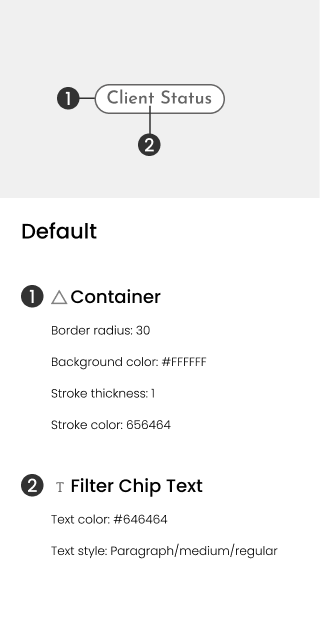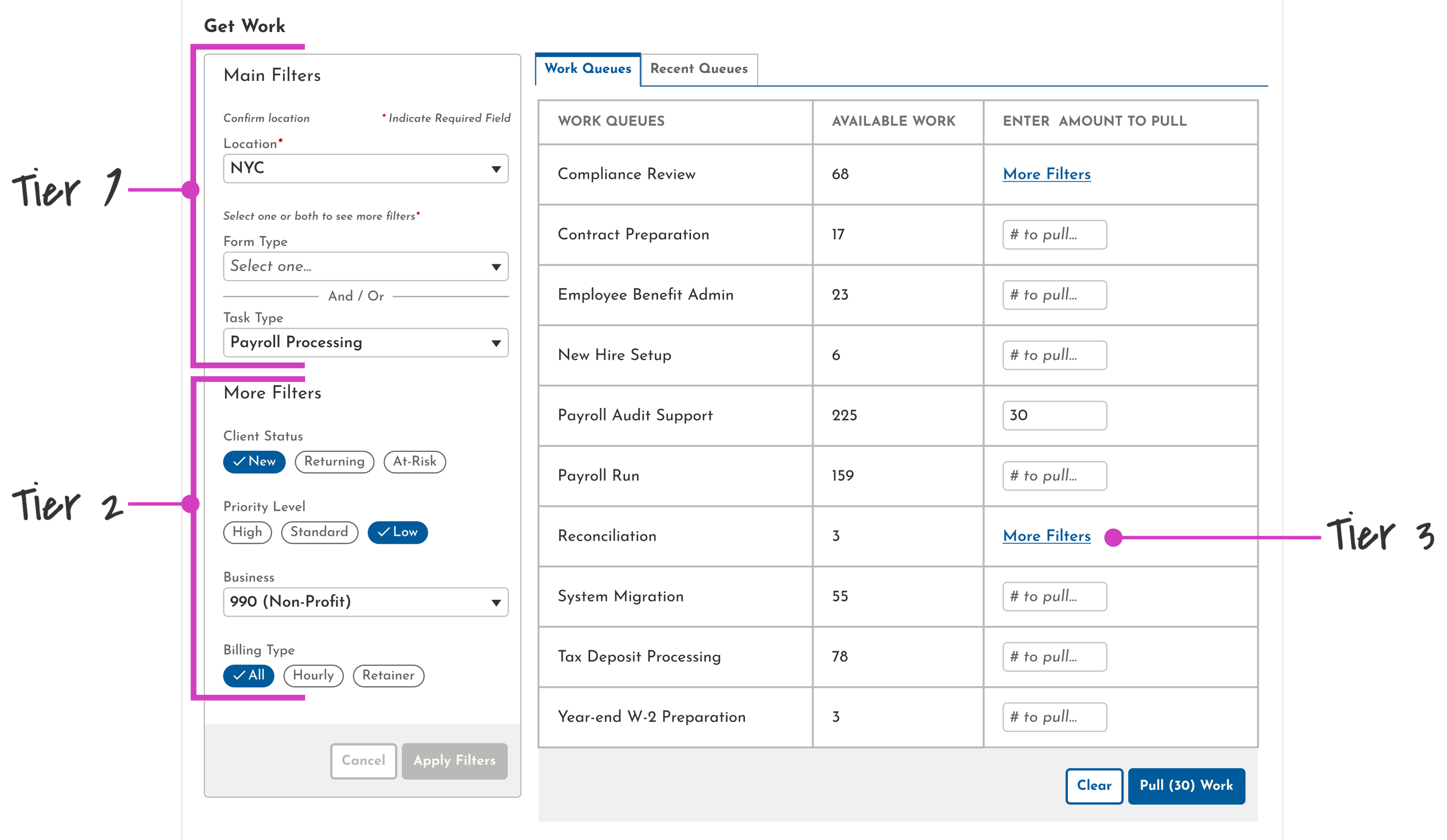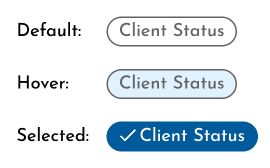Get Work
Redesigning a Critical
Filtering System
for 4,000+ Users
Project Overview
Role: UX Designer (+2 other UX designers)
Team: 10 Developers, 2 Product Managers, SMEs
Platform: Nationwide accounting application
Project details have been modified to protect confidential business information.
The Challenge
The Get Work feature serves as the primary gateway for thousands of users across the country to access their daily tasks. However, this critical feature was failing users in significant ways:
The Problem: 20% of tasks pulled through the system were unworkable and had to be sent back to the work queue—a costly inefficiency that frustrated users and impacted business operations.
Additional Issues:
Rigid filtering system with cascading dropdowns, users had to navigate through multiple dependent dropdowns before seeing any results
Data inconsistency caused mistrust in the system's accuracy
Scalability issues as the business grew, adding new filters became increasingly messy and unmanageable
Research & Discovery:
To understand the full scope of the problem, we did a comprehensive research initiative:
User Pain Points Investigation:
Conducted an in-depth analysis of user-reported tickets and complaints
Analyzed user behavior and journey analytics to identify friction points
Interviewed Subject Matter Experts (SMEs) across different product lines to understand workflow variations
Key Insight: The rigid filtering structure wasn't just a usability problem—it was fundamentally misaligned with how different user workflows actually operated. The one-size-fits-all approach was failing to meet diverse users across the nationwide platform.
Backend Investigation: This revealed that data architecture problems were undermining user trust in the system. Inconsistent labeling and fragmented database relationships meant users couldn't rely on filtered results, causing unworkable tasks being pulled. This backend chaos was creating frontend user experience failures
PROCESS
🔹
PROCESS 🔹
Collaborative Problem-Solving
Working closely with Product Managers and the development team, started with whiteboarding sessions to explore viable solutions that balanced technical feasibility with business needs and user requirements.
Mapping Complexity
To help developers understand the intricate relationships between filters, we provided a detailed form mapping that visualized the dynamic filtering logic, showing exactly which options should appear based on selections.
Design System Considerations
When exploring solutions, we initially considered toggle switches for their clean appearance. However, after thorough evaluation, toggles didn't align with our design system guidelines (toggles should provide instant feedback, but our filtering required an "apply" action). This led us to propose chip filtering—a more suitable pattern then we fully document the specification to add to our design system.
Filter Chip
Spec sample
Core Improvements:
1. Flexible Filtering Architecture
Replaced rigid cascading dropdowns with a filter panel that can scale up as needed
3-tier filtering to structure the backend architecture while improving usability:
Tier 1: Auto-populated location filters and required form/task type filtering
Tier 2: Expanded filter options based on selections
Tier 3: Additional work queue-specific filters
2. Enhanced Visual Design
Chip filtering interface helps users see selections at once. This interface applies with 2-3 options, eliminating extra clicks to view the dropdown
Cleaner, more scalable visual hierarchy
Full alignment with design system standards
3. Backend Architecture Cleanup
Standardized labeling across the system to ensure consistency
Eliminated confusing use of labels that contributed to data mistrust
Validation & Quality Assurance
Built interactive prototypes for usability testing to gather user feedback
Provided comprehensive design annotations for quality control to the dev team
Established success metrics: Both old and new Get Work features will run parallel for 3 months, with success measured by user adoption of the new system
Impact & Results:
eXperience
Improvement
Increased flexibility
Users now have significantly more control over their filtering experience
Improved efficiency
Streamlined interaction model reduces clicks and cognitive load
Enhanced trust
Consistent data labeling and improved accuracy
Business
Benefits
Scalable solution
New architecture can grow with business needs without becoming unwieldy
Technical efficiency
More efficient filtering method enables faster, more accurate task retrieval
Reduced waste
Targeting the 20% unworkable task rate to improve operational efficiency
Currently measuring success metrics with parallel system deployment.
Key Learnings:
Having a great team for this project made it all the more engaging. Great minds, great people, lots of laughter in the midst of this super complex project….what else can a person ask for?! 🥹💖
Cross-functional collaboration
Early sharing of research insights with developers and product managers enabled the entire team to approach the project holistically, resulting in better technical and business alignment.
Design system evolution
Sometimes the best solution requires expanding your design system—advocating for chip filtering ultimately strengthened our overall design language.
Phased delivery
Strategic implementation phases allowed us to meet aggressive timelines while maintaining quality standards.







